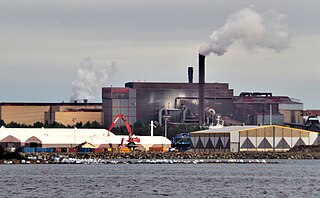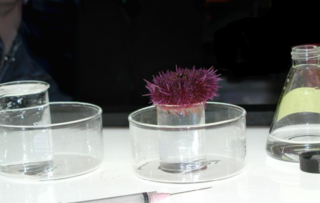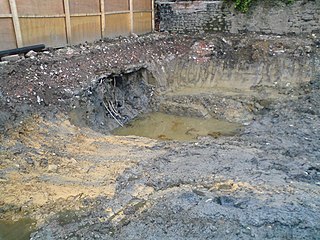Bioaccumulation is the gradual accumulation of substances, such as pesticides or other chemicals, in an organism. Bioaccumulation occurs when an organism absorbs a substance at a rate faster than that at which the substance is lost or eliminated by catabolism and excretion. Thus, the longer the biological half-life of a toxic substance, the greater the risk of chronic poisoning, even if environmental levels of the toxin are not very high. Bioaccumulation, for example in fish, can be predicted by models. Hypothesis for molecular size cutoff criteria for use as bioaccumulation potential indicators are not supported by data. Biotransformation can strongly modify bioaccumulation of chemicals in an organism.
Chronic toxicity, the development of adverse effects as a result of long term exposure to a contaminant or other stressor, is an important aspect of aquatic toxicology. Adverse effects associated with chronic toxicity can be directly lethal but are more commonly sublethal, including changes in growth, reproduction, or behavior. Chronic toxicity is in contrast to acute toxicity, which occurs over a shorter period of time to higher concentrations. Various toxicity tests can be performed to assess the chronic toxicity of different contaminants, and usually last at least 10% of an organism's lifespan. Results of aquatic chronic toxicity tests can be used to determine water quality guidelines and regulations for protection of aquatic organisms.

Environmental remediation deals with the removal of pollution or contaminants from environmental media such as soil, groundwater, sediment, or surface water. Remedial action is generally subject to an array of regulatory requirements, and may also be based on assessments of human health and ecological risks where no legislative standards exist, or where standards are advisory.

Environmental chemistry is the scientific study of the chemical and biochemical phenomena that occur in natural places. It should not be confused with green chemistry, which seeks to reduce potential pollution at its source. It can be defined as the study of the sources, reactions, transport, effects, and fates of chemical species in the air, soil, and water environments; and the effect of human activity and biological activity on these. Environmental chemistry is an interdisciplinary science that includes atmospheric, aquatic and soil chemistry, as well as heavily relying on analytical chemistry and being related to environmental and other areas of science.

Aquatic toxicology is the study of the effects of manufactured chemicals and other anthropogenic and natural materials and activities on aquatic organisms at various levels of organization, from subcellular through individual organisms to communities and ecosystems. Aquatic toxicology is a multidisciplinary field which integrates toxicology, aquatic ecology and aquatic chemistry.

Soil contamination, soil pollution, or land pollution as a part of land degradation is caused by the presence of xenobiotic (human-made) chemicals or other alteration in the natural soil environment. It is typically caused by industrial activity, agricultural chemicals or improper disposal of waste. The most common chemicals involved are petroleum hydrocarbons, polynuclear aromatic hydrocarbons, solvents, pesticides, lead, and other heavy metals. Contamination is correlated with the degree of industrialization and intensity of chemical substance. The concern over soil contamination stems primarily from health risks, from direct contact with the contaminated soil, vapour from the contaminants, or from secondary contamination of water supplies within and underlying the soil. Mapping of contaminated soil sites and the resulting cleanups are time-consuming and expensive tasks, and require expertise in geology, hydrology, chemistry, computer modeling, and GIS in Environmental Contamination, as well as an appreciation of the history of industrial chemistry.
In biomedical contexts, a biomarker, or biological marker, is a measurable indicator of some biological state or condition. Biomarkers are often measured and evaluated using blood, urine, or soft tissues to examine normal biological processes, pathogenic processes, or pharmacologic responses to a therapeutic intervention. Biomarkers are used in many scientific fields.

Macrobenthos consists of the organisms that live at the bottom of a water column and are visible to the naked eye. In some classification schemes, these organisms are larger than 1 mm; in another, the smallest dimension must be at least 0.5 mm. They include polychaete worms, pelecypods, anthozoans, echinoderms, sponges, ascidians, crustaceans.
In-Situ Capping (ISC) of Subaqueous Waste is a non-removal remediation technique for contaminated sediment that involves leaving the waste in place and isolating it from the environment by placing a layer of soil and/or material over the contaminated waste as to prevent further spread of the contaminant. In-situ capping provides a viable way to remediate an area that is contaminated. It is an option when pump and treat becomes too expensive and the area surrounding the site is a low energy system. The design of the cap and the characterization of the surrounding areas are of equal importance and drive the feasibility of the entire project. Numerous successful cases exist and more will exist in the future as the technology expands and grows more popular. In-situ capping uses techniques developed in chemistry, biology, geotechnical engineering, environmental engineering, and environmental geotechnical engineering.
Toxic equivalency factor (TEF) expresses the toxicity of dioxins, furans and PCBs in terms of the most toxic form of dioxin, 2,3,7,8-TCDD. The toxicity of the individual congeners may vary by orders of magnitude.
In aquatic toxicology, bioconcentration is the accumulation of a water-borne chemical substance in an organism exposed to the water.
In environmental toxicology, effects range low (ERL) and effects range median (ERM) are measures of toxicity in marine sediment. They are used by public agencies in the United States in formulating guidelines in assessing toxicity hazards, in particular from trace metals or organic contaminants.
Pollution-induced community tolerance (PICT) is an approach to measuring the response of pollution-induced selective pressures on a community. It is an eco-toxicological tool that approaches community tolerance to pollution from a holistic standpoint. Community Tolerance can increase in one of three ways: physical adaptations or phenotypic plasticity, selection of favorable genotypes, and the replacement of sensitive species by tolerant species in a community.
Persistent, bioaccumulative and toxic substances (PBTs) are a class of compounds that have high resistance to degradation from abiotic and biotic factors, high mobility in the environment and high toxicity. Because of these factors PBTs have been observed to have a high order of bioaccumulation and biomagnification, very long retention times in various media, and widespread distribution across the globe. Most PBTs in the environment are either created through industry or are unintentional byproducts.
Tissue residue is the concentration of a chemical or compound in an organism's tissue or in a portion of an organism's tissue. Tissue residue is used in aquatic toxicology to help determine the fate of chemicals in aquatic systems, bioaccumulation of a substance, or bioavailability of a substance, account for multiple routes of exposure, and address an organism's exposure to chemical mixtures. A tissue residue approach to toxicity testing is considered a more direct and less variable measure of chemical exposure and is less dependent on external environmental factors than measuring the concentration of a chemical in the exposure media.
Simultaneously extracted metals/Acid-volatile sulfide (SEM-AVS) is an approach used in the field of aquatic toxicology to assess the potential for metal ions found in sediment to cause toxic effects in organisms dwelling in the sediment. In this approach, the amounts of several heavy metals in a sediment sample are measured in a laboratory; at the same time, the amount of acid-volatile sulfide is determined. Based on the chemical interactions between heavy metals (SEM) and acid-volatile sulfide (AVS), the concentrations of these two components can be used to assess the potential for toxicity to sediment-dwelling organisms.

The U.S. National Oceanic and Atmospheric Administration (NOAA) National Status and Trends (NS&T) Mussel Watch Program is a water contaminant monitoring program that started in 1986. It is the longest running continuous contaminant monitoring program of its kind in the United States. Mussel Watch monitors the concentration of contaminants in bivalves and sediments in the coastal waters of the U.S., including the Great Lakes, to monitor bivalve health and by extension the health of their local and regional environment.
Equilibrium partitioning Sediment Benchmarks (ESBs) are a type of Sediment Quality Guideline (SQG) derived by the US Environmental Protection Agency (EPA) for the protection of benthic organisms. ESBs are based on the bioavailable concentration of contaminants in sediments rather than the dry-weight concentration. It has been demonstrated that sediment concentrations on a dry-weight basis often do not predict biological effects. Interstitial water concentrations, however, predict biological effects much better. This is true because the chemical present in the interstitial water (or pore water) is the uncomplexed/free phase of the chemical that is bioavailable and toxic to benthic organisms. Other phases of the chemical are bound to sediment particles like organic carbon (OC) or acid volatile sulfides (AVS) and are not bioavailable. Thus the interstitial water concentration is important to consider for effects to benthic organisms.
Toxicological databases are large compilations of data derived from aquatic and environmental toxicity studies. Data is aggregated from a large number of individual studies in which toxic effects upon aquatic and terrestrial organisms have been determined for different chemicals. These databases are then used by toxicologists, chemists, regulatory agencies and scientists to investigate and predict the likelihood that an organic or inorganic chemical will cause an adverse effect on exposed organisms.
Toxic units (TU) are used in the field of toxicology to quantify the interactions of toxicants in binary mixtures of chemicals. A toxic unit for a given compound is based on the concentration at which there is a 50% effect for a certain biological endpoint. One toxic unit is equal to the EC50 for a given endpoint for a specific biological effect over a given amount of time. Toxic units allow for the comparison of the individual toxicities of a binary mixture to the combined toxicity. This allows researchers to categorize mixtures as additive, synergistic or antagonistic. Synergism and antagonism are defined by mixtures that are more or less toxic than predicted by the sum of their toxic units.





